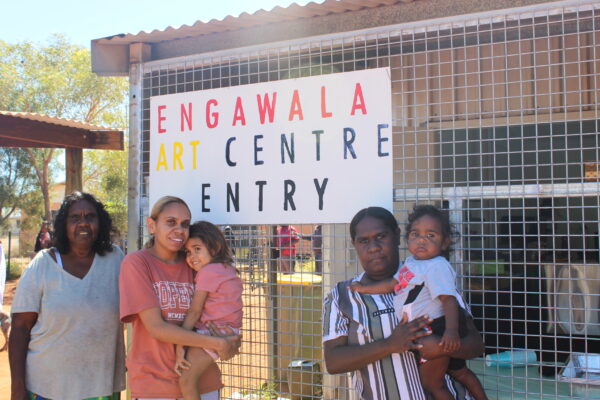
The old store in Engawala has been given a new lease of life, opening as an arts centre.
With few jobs in the community, Engawala’s many talented artists now have a dedicated space to work and earn an income from arts and crafts sales.
Tourists often drop in on Engawala, 200 kilometres northeast of Alice Springs, because the community is next to the Alcoota fossil fields. Those visitors now have a proper place to view and buy the artists’ work.
“The community are really supportive of the arts centre. Especially the board as well and Joy Turner, the elder for this community,” arts centre manager and Engawala local Janine Tilmouth said.
“We did this project so that there was a chance for people to have work and also to have their own community-owned arts centre, instead of someone else coming in and running it,” she said.
They first talked about turning the old store into an arts centre four years ago.
The community allocated a total of $145,000 to the renovation, which was made up of community lease money and matched funds from the National Indigenous Australians Agency.
Four residents then met with the Central Land Council’s community development team and Tangentyere Constructions to work out the details.
“The workers gave the old store a good clean-out and got electricity, benches and drawers,” resident artist Sharon Tilmouth said.
They boarded up some doors and fixed broken windows to make the building safe.
“We had to wait a while to get the work done, but Tangentyere Constructions did a good job,” Janine Tilmouth said.
“They listened to the community and suggested what would be good, with the sink and putting the drawers in.”
Tangentyere Constructions hired local residents Stewart Schaber and Leanne Dodd for some of the work and finished the job within six weeks.
“I helped pull out the fridges and I was painting the wall and glazing the floor. It’s the first time I’ve done this kind of work,” Ms Dodd said.
“I liked getting to work on time and communicating with the other workers.”
She also helped Tangentyere’s Aboriginal tradies Corey Coull and Adrian Shaw to coat the floor and install the benches and trolleys.
Ms Dodds is a local artist and helped the other artists with the designs painted on the floor.
The locals took over the centre ahead of the official launch in August.
“The arts centre looks good inside now. We’ve already started to work in the arts centre, doing paintings. I’m working at the shop now.”
Volunteers from Community First Development, a national organisation which connects skilled volunteers with Aboriginal communities, Taffy Denmark and Marella Pettinato were a big part of the project.
They helped write a business plan and sourced a $100,000 grant from the Aboriginals Benefit Account to paint the old store and build a shade structure. Now the artists can paint outside in good weather.
The money also paid for an eco-toilet, art equipment, insurances, governance training and project management.
During a year-long construction delay staff took part in intensive administration training.
“I got a lot of training from the volunteer Marella, for admin and bookkeeping and getting work-ready for the auditor. It’s a lot of work and I’ve learnt a lot,” said Janine Tilmouth.
Artists are also getting training from art professionals, and 12 community members have enrolled with the Batchelor College to complete visual arts certificates.
“The ladies have been screen printing,” Sharon Tilmouth said. “There was a workshop and one lady taught us. Lots of ladies have been using the arts centre and they’re happy with it.”
A $400,000 grant from the Indigenous Visual Arts Industry Support program pays for a website, the wages of two local art workers for two years and covers the costs of attending interstate art fairs.
Janine Tilmouth said the centre will build on sales through the art fairs and allow them to explore other markets.
“Maybe we can take our artworks to the cities, spread the word and add more to the website,” she said.
The Engawala art centre shows what can be achieved when Aboriginal people work with a lot of different people and organisations to drive their own development.
The money for this project came from the income the community receives from leases of its land and a three-year trial by the CLC and the NIAA.
The matched funds trial funds groups that use new income from land use agreements for community driven projects, but may not have enough money for the projects they want.
If you would like more information about this work please visit https://www.clc.org.au/strengthening-our-communities/
